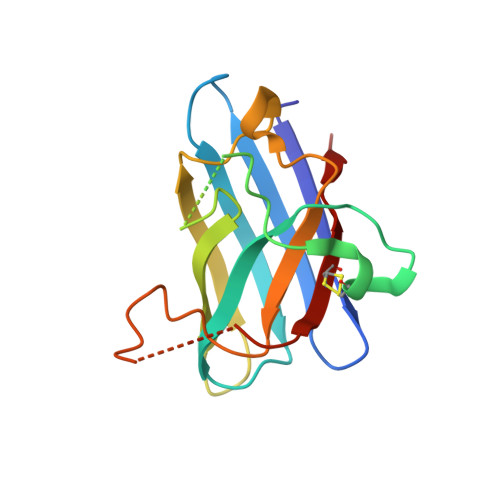Structural characterization of zinc-deficient human superoxide dismutase and implications for ALS.
Roberts, B.R., Tainer, J.A., Getzoff, E.D., Malencik, D.A., Anderson, S.R., Bomben, V.C., Meyers, K.R., Karplus, P.A., Beckman, J.S.(2007) J Mol Biol 373: 877-890
- PubMed: 17888947
- DOI: https://doi.org/10.1016/j.jmb.2007.07.043
- Primary Citation of Related Structures:
2R27 - PubMed Abstract:
Over 130 mutations to copper, zinc superoxide dismutase (SOD) are implicated in the selective death of motor neurons found in 25% of patients with familial amyotrophic lateral sclerosis (ALS). Despite their widespread distribution, ALS mutations appear positioned to cause structural and misfolding defects. Such defects decrease SOD's affinity for zinc, and loss of zinc from SOD is sufficient to induce apoptosis in motor neurons in vitro. To examine the importance of the zinc site in the structure and pathogenesis of human SOD, we determined the 2.0-A-resolution crystal structure of a designed zinc-deficient human SOD, in which two zinc-binding ligands have been mutated to hydrogen-bonding serine residues. This structure revealed a 9 degrees twist of the subunits, which opens the SOD dimer interface and represents the largest intersubunit rotational shift observed for a human SOD variant. Furthermore, the electrostatic loop and zinc-binding subloop were partly disordered, the catalytically important Arg143 was rotated away from the active site, and the normally rigid intramolecular Cys57-Cys146 disulfide bridge assumed two conformations. Together, these changes allow small molecules greater access to the catalytic copper, consistent with the observed increased redox activity of zinc-deficient SOD. Moreover, the dimer interface is weakened and the Cys57-Cys146 disulfide is more labile, as demonstrated by the increased aggregation of zinc-deficient SOD in the presence of a thiol reductant. However, equimolar Cu,Zn SOD rapidly forms heterodimers with zinc-deficient SOD (t1/2 approximately 15 min) and prevents aggregation. The stabilization of zinc-deficient SOD as a heterodimer with Cu,Zn SOD may contribute to the dominant inheritance of ALS mutations. These results have general implications for the importance of framework stability on normal metalloenzyme function and specific implications for the role of zinc ion in the fatal neuropathology associated with SOD mutations.
Organizational Affiliation:
Department of Biochemistry and Biophysics, Oregon State University, Corvallis, OR 97331, USA.















